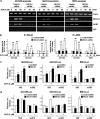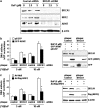Detoxification: a novel function of BRCA1 in tumor suppression?
- PMID: 21507987
- PMCID: PMC3143468
- DOI: 10.1093/toxsci/kfr089
Detoxification: a novel function of BRCA1 in tumor suppression?
Abstract
Our studies found that BRCA1 levels negatively correlate with DNA adducts induced by Benzo(a)pyrene (BaP). Pulse-chase experiments showed that the increase in BaP-induced DNA adducts in BRCA1 knockdown cells may not be associated with BRCA1's function in nucleotide excision repair activity; rather, it may be associated with its function in modulating transcriptional regulation. BRCA1 knockdown in MCF-10A cells significantly attenuated the induction of CYP1A1 following BaP treatment indicating that the increase in BaP-induced adducts in BRCA1 knockdown cells is not CYP1A1 dependent. However, our study shows that BRCA1 defective cells may still be able to biotransform BaP by regulating other CYP enzymes, including CYP1B1. Knockdown of BRCA1 also severely affected the expression levels of two types of uridine diphosphate glucorunyltransferase (UGT1A1 and UGT1A9) and NRF2. Both UGTs are known as BaP-specific detoxification enzymes, and NRF2 is a master regulator of antioxidant and detoxification genes. Thus, we concluded that the increased amount of BaP-induced DNA adducts in BRCA1 knockdown cells is strongly associated with its loss of functional detoxification. Chromatin immunoprecipitation assay revealed that BRCA1 is recruited to the promoter/enhancer sequences of UGT1A1, UGT1A9, and NRF2. Regulation of UGT1A1 and UGT1A9 expression showed that the induction of DNA adducts by BaP is directly affected by their expression levels. Finally, overexpression of UGTs, NRF2, or ARNT significantly decreased the amount of BaP-induced adducts in BRCA1-deficient cells. Overall, our results suggest that BRCA1 protects cells by reducing the amount of BaP-induced DNA adducts possibly via transcriptional activation of detoxification gene expression.
Figures








Similar articles
-
Influence of cell cycle on responses of MCF-7 cells to benzo[a]pyrene.BMC Genomics. 2011 Jun 29;12:333. doi: 10.1186/1471-2164-12-333. BMC Genomics. 2011. PMID: 21714911 Free PMC article.
-
Tissue specific induction of cytochrome P450 (CYP) 1A1 and 1B1 in rat liver and lung following in vitro (tissue slice) and in vivo exposure to benzo(a)pyrene.Toxicol In Vitro. 2006 Jun;20(4):426-38. doi: 10.1016/j.tiv.2005.08.015. Epub 2005 Sep 28. Toxicol In Vitro. 2006. PMID: 16198082
-
Benzo[a]pyrene-induced toxicity: paradoxical protection in Cyp1a1(-/-) knockout mice having increased hepatic BaP-DNA adduct levels.Biochem Biophys Res Commun. 2001 Dec 21;289(5):1049-56. doi: 10.1006/bbrc.2001.6110. Biochem Biophys Res Commun. 2001. PMID: 11741297
-
Overexpression of Cu/Zn-superoxide dismutase and/or catalase accelerates benzo(a)pyrene detoxification by upregulation of the aryl hydrocarbon receptor in mouse endothelial cells.Free Radic Biol Med. 2009 Oct 15;47(8):1221-9. doi: 10.1016/j.freeradbiomed.2009.08.001. Epub 2009 Aug 7. Free Radic Biol Med. 2009. PMID: 19666105 Free PMC article.
-
Oral benzo[a]pyrene: understanding pharmacokinetics, detoxication, and consequences--Cyp1 knockout mouse lines as a paradigm.Mol Pharmacol. 2013 Sep;84(3):304-13. doi: 10.1124/mol.113.086637. Epub 2013 Jun 12. Mol Pharmacol. 2013. PMID: 23761301 Free PMC article. Review.
Cited by
-
BRCA1 and Oxidative Stress.Cancers (Basel). 2014 Apr 3;6(2):771-95. doi: 10.3390/cancers6020771. Cancers (Basel). 2014. PMID: 24704793 Free PMC article.
-
Estrogen potentiates reactive oxygen species (ROS) tolerance to initiate carcinogenesis and promote cancer malignant transformation.Tumour Biol. 2016 Jan;37(1):141-50. doi: 10.1007/s13277-015-4370-6. Epub 2015 Nov 13. Tumour Biol. 2016. PMID: 26566628 Review.
-
Breast cancer susceptibility protein 1 (BRCA1) rescues neurons from cerebral ischemia/reperfusion injury through NRF2-mediated antioxidant pathway.Redox Biol. 2018 Sep;18:158-172. doi: 10.1016/j.redox.2018.06.012. Epub 2018 Jul 7. Redox Biol. 2018. PMID: 30014904 Free PMC article.
-
Transcription Factor NRF2 in Shaping Myeloid Cell Differentiation and Function.Adv Exp Med Biol. 2024;1459:159-195. doi: 10.1007/978-3-031-62731-6_8. Adv Exp Med Biol. 2024. PMID: 39017844 Review.
-
How to deal with frenemy NRF2: Targeting NRF2 for chemoprevention and cancer therapy.J Food Drug Anal. 2023 Aug 31;31(3):387-407. doi: 10.38212/2224-6614.3463. J Food Drug Anal. 2023. PMID: 39666284 Free PMC article. Review.
References
-
- Abbott DW, Thompson ME, Robinson-Benion C, Tomlinson G, Jensen RA, Holt JT. BRCA1 expression restores radiation resistance in BRCA1-defective cancer cells through enhancement of transcription-coupled DNA repair. J. Biol. Chem. 1999;274:18808–18812. - PubMed
-
- Ali AB, Iau PT, Sng JH. Cancer-specific methylation in the BRCA1 promoter in sporadic breast tumours. Med. Oncol. 2011;28:64–66. - PubMed
-
- Bae I, Fan S, Meng Q, Rih JK, Kim HJ, Kang HJ, Xu J, Goldberg ID, Jaiswal AK, Rosen EM. BRCA1 induces antioxidant gene expression and resistance to oxidative stress. Cancer Res. 2004;64:7893–7909. - PubMed
-
- Bochar DA, Wang L, Beniya H, Kinev A, Xue Y, Lane WS, Wang W, Kashanchi F, Shiekhattar R. BRCA1 is associated with a human SWI/SNF-related complex: linking chromatin remodeling to breast cancer. Cell. 2000;102:257–265. - PubMed
-
- Breast Cancer Family Registry, Kathleen Cuningham Consortium for Research into Familial Breast Cancer (Australasia), Ontario Cancer Genetics Network (Canada) Smoking and risk of breast cancer in carriers of mutations in BRCA1 or BRCA2 aged less than 50 years. Breast Cancer Res. Treat. 2008;109:67–75. - PMC - PubMed
Publication types
MeSH terms
Substances
LinkOut - more resources
Full Text Sources
Molecular Biology Databases
Miscellaneous

